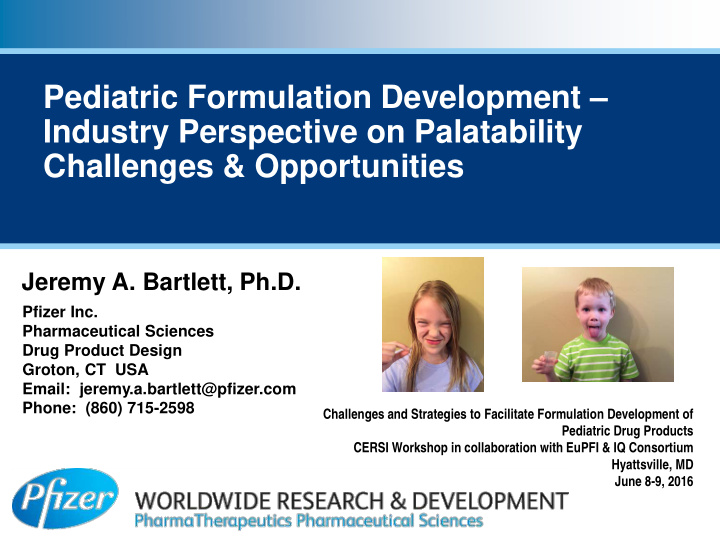



Pediatric Formulation Development – Industry Perspective on Palatability Challenges & Opportunities Jeremy A. Bartlett, Ph.D. Pfizer Inc. Pharmaceutical Sciences Drug Product Design Groton, CT USA Email: jeremy.a.bartlett@pfizer.com Phone: (860) 715-2598 Challenges and Strategies to Facilitate Formulation Development of Pediatric Drug Products CERSI Workshop in collaboration with EuPFI & IQ Consortium Hyattsville, MD June 8-9, 2016
Acknowledgements Pfizer US Pfizer UK • Murdande, Sharad • Cram, Anne – EuPFI • Prpich, Andrew • Coupe, Alastair • Ciringh, Yangzhen – Innovate UK Pediatric Consortium • Nixon, Phil • Bennett, Jo • Korsmeyer, Richard • Carmody, Alan • Thombre, Avi • McGovern, James • Sagawa, Kazuko • Contreras, Lourdes Pfizer Global Pediatric Center of • Turnbull, Neil Excellence • English, Cheryl • Ogilvie, Ron • Thompson, Charlie • Simmons, Joanna • Darsey, Edress • Forbes, Claire Institute of Pediatric Innovation Pfizer US (IPI) • Santangelo, Matt • Herbig, Scott M Others I am sure I have missed… Shanker, Ravi M • • Heimlich, John H • Hausberger, Angie
Outline • Why is palatability important? • What makes developing a palatable formulation challenging? • What can be done? 3
Why is palatability important? Bartlett Household Example 1
Why is palatability important? Bartlett Household Example 2
Why is Taste of Medicines Important ? • Even the best medicine won’t work unless the child takes it! • A 2003 survey of pediatricians conducted by the American Association of Pediatrics found – Unpleasant taste was the biggest barrier for completing treatments in pediatrics 1 • Average compliance rate in children is ~58% , with major factors attributed to formulation and palatability 2 1 Ayenew, Z., V. Puri, L. Kumar and A. K. Bansal (2009). "Trends in pharmaceutical taste masking technologies: a patent review." Recent Pat. Drug Delivery Formulation 3 (1): 26-39. 2 Matsui, D. (2007). "Current issues in pediatric medication adherence." Paediatr Drugs 9 (5): 283-288. 6
Outline • Why is palatability important? • What makes developing a palatable formulation challenging? • What can be done? 7
Challenges in developing pediatric formulations • Diverse patient group – Birth to age ~ 18 – Size/Weight change over 20 fold – Dose adjustment >3-4 fold – Ability to take and preference of dosage form varies across the wide age range • Palatability – Cultural and geographical preferences – Restrictions related to use of excipients (type and quantity) – Taste assessment vs. compliance • How do you know when you are “good enough?” – What palatability information should you use to drive formulation development? • Adult Healthy Volunteers • Trained Adult Taste Panel • Pediatric Patients • In vitro • Keeping in mind, palatability is only one part of dosage form acceptability! 8
Outline • Why is palatability important? • What makes developing a palatable formulation challenging? • What can be done? 9
Pediatric Oral Dosage Form Decision Tree Target Product Profile Yes No Dose Flexibility Required? Acceptable Acceptable No No Yes Yes Taste? Taste? API soluble Yes No at required dose? Oral Solid: Taste- Chewable Oral Solid: masked Tablet or Taste-masked Microspheres Oral Microspheres Oral Oral Sachet or Disintegrating ODT, Sachet Solution Suspension Sprinkle Tablet or Sprinkle Stability ? Yes RTU No POS Walsh, J., A. Cram, K. Woertz, J. Breitkreutz, G. Winzenburg, R. Turner and C. Tuleu (2014). "Playing hide and seek with poorly tasting paediatric medicines: Do not forget the excipients." Adv. Drug Delivery Rev. 73 : 14-33.
Pediatric Dosage Form Technologies: Small Molecule Pediatric Products -- oral Ready to Use (RTU) Oral Solution or Oral Suspension Dosed using a syringe, dosing cup, or dosing spoon Powder for Oral Solution or Powder for Oral Suspension (POS) Constituted with water by the Pharmacist Dosed using a syringe, dosing cup, or dosing spoon Being implemented! Taste-masked Microspheres • Prevent drug release until the microspheres clear the mouth – achieve “taste neutral” profile • Spherical coated multiparticulates • Stability in Zone 4 (global) • Reduce/Eliminate the need for flavors, sugars, preservatives • Packaging include bottles, sachet, capsules (other presentations are also possible) • Potential dosing with or without water 11
Pediatric Multiparticulate Platform Summary • Oral Multiparticulates provide an excellent platform for pediatric medicines – Ideal substrate for taste masking – Dose Flexibility – Reduce/Eliminate need for preservatives, sweeteners, flavorants, dyes, etc – May be dosed w/wo water • To be successful three main Step 1. Make focus areas the multiparticulate a) Multiparticulate b) Barrier Coating c) Dosing and Administration, Device/Packaging Running Open Innovation Challenge to Step 3. generate ideas on the best way to Process and Step 2. Barrier accurately dispense and administer the Package into coat the the final drug multiparticulate multiparticulates product 12
Institute of Pediatric Innovation and Pfizer collaborate on open innovation pediatric device challenge Expect to announce awardee ~ August 2016 www.pfizer.com/responsibility/grants_contributions/device_challenge 13
Conclusions & Opportunities • Connecting taste assessment evaluations with compliance data would be very helpful • Providing taste evaluation feedback early in adult clinical development can help guide technology selection • Oral Multiparticulates provide an excellent platform for pediatric medicines • Still working on – – What is the “ideal” barrier membrane? – What is the “best” way to dispense and administer a free flowing, non gritty, tasteless powder? 14
Recommend
More recommend